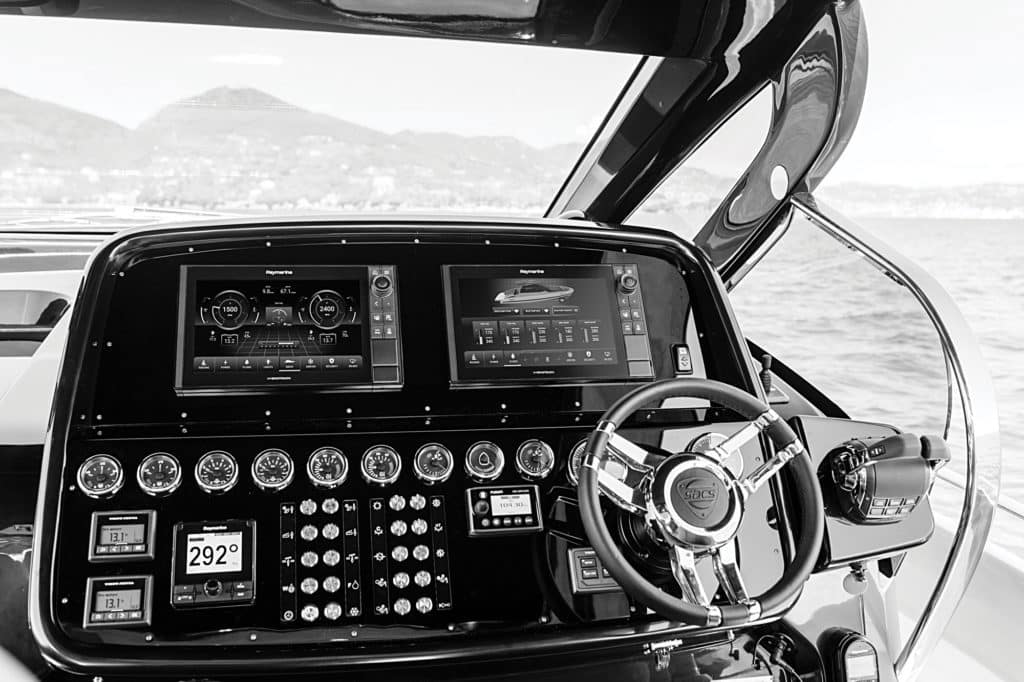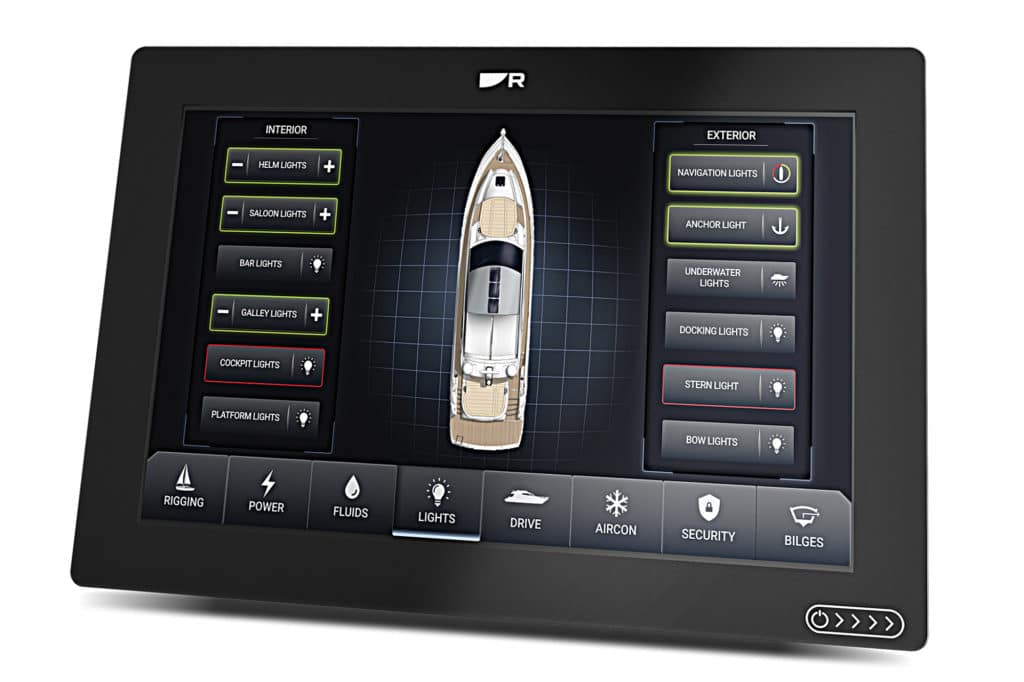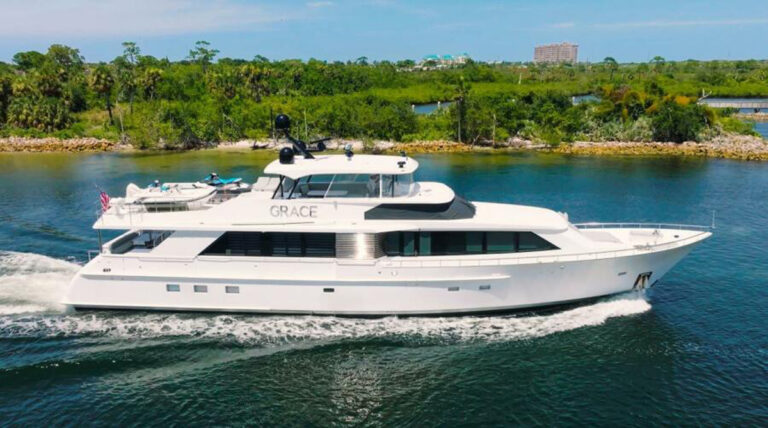
Mea Culpa: I snaked my best friend’s spot in line to buy a Nest thermostat when the devices became available in late 2011. While a few nice bottles of wine were required to smooth over this trespass, it was worth it. The Nest thermostat constantly downcycled my furnace, saving money.
This device was a harbinger of future smart technologies. I can remember daydreaming back then about how cool it would be if this same level of connectivity extended down the dock.
Now, Raymarine’s YachtSense is making that daydream a reality.
Unlike other digital-switching and control systems, YachtSense is a marine-specific system that gives boaters control over all networked devices and systems, ranging from lights and air conditioning to wine chillers and cameras. With YachtSense, they can all be controlled from a multifunction display or wireless device.
Also, while most systems are pre-configured to control networked equipment, YachtSense modules are made up of individual digital-switching controls—“bricks,” in Raymarine parlance—that perform different tasks and tackle different loads. These bricks snap together Lego-style, allowing YachtSense modules to be customized for a yacht, its equipment and its location-specific needs.
The result is that YachtSense delivers impressive levels of automation, redundancy and scalability. The system can let yacht owners power on and off—and sometimes control—onboard equipment and systems from afar.
Each YachtSense module is composed of a master and power-supply brick, plus inner bricks configured to match the demands of networked equipment. These inner bricks include low-power, high-power, reverse-power and signal-module bricks. A power-supplying bus bar runs through each module, powering the inner bricks and their downstream networked devices and systems.
While each module’s composition depends on the equipment it needs to power and control, the configurable inner bricks are always bookended by the master and power-supply bricks. “Installers can put [together] up to six bricks to make a module,” says Jim McGowan, Raymarine’s Americas marketing manager, adding that this limitation is practical. “We need to account for flexing,” such as when a boat is in heavy seas.

YachtSense’s power-supply brick provides 100 amps of DC power from the yacht’s battery bank or generator to the module’s inner bricks. The low-power bricks deliver 10 amps (or less) for items such as lights and wiper motors, and each low-power brick can support four devices or systems. High-power bricks deliver 10 to 20 amps to items such as pumps, fans, heaters and refrigerators, and each high-power brick can support two networked devices or systems.
Reverse-power bricks give owners control over one 20-amp circuit. These bricks can reverse the polarity of a connected circuit, giving owners two-way control over items such as windlasses, electric winches, sunroofs and shades. “It can [also] sense the current—for example, on a swim platform—so that if it hits resistance, it doesn’t crunch something,” McGowan says. “This adds intelligence to the system.”
Signal bricks can monitor four networked items such as battery and tank levels, temperatures, and switches; they can also be used to control relays or devices.
YachtSense’s master brick provides one NMEA 2000 (or Raymarine SeaTalkNG) port, a Raymarine SeaTalkHS port, two J1939 connections (such as engine controls), and two RS-485 connections (such as HVAC controls). The master brick connects to the yacht’s multifunction display, and it also sports an LCD screen and keyboard.
While YachtSense modules are limited to six bricks, there’s no limit to the number of installed modules or number of networked devices and systems that YachtSense can control. (In multiple-module installations, the first module is fitted with a master brick while other modules are fitted with remote-module bricks.)
A separate YachtSense Connect black box is required to control the system from afar via the Ray Connect app. For example, users can spool up a Seakeeper gyrostabilizer or start up a FLIR thermal-imaging camera so everything is ready to go when they step aboard. Also, McGowan says, with the right networking, an owner could pan, tilt, zoom and view his FLIR cameras from afar.
YachtSense Connect boxes have an embedded 4G cellular router, and they can be networked with satellite-communications systems. Additional modules can be added to an installation later. This expandability ensures that YachtSense can mature with a yacht’s electronics.
YachtSense systems are built to IPX6 standards; however, there’s always the remote chance that the system—or its controlling multifunction display or network—could be compromised. To prevent calamity, YachtSense provides triple-layer redundancy on each circuit. Should problems arise, YachtSense reverts to its limp-home mode, providing power to critical circuits such as the engines and running lights. Should the multifunction display fail, users can control YachtSense via the master brick’s keypad and LCD screen. Finally, each inner brick has a removable rubber cap that exposes manual fuses; any circuit can be manually switched on or off by moving the fuses into their bypass positions.
YachtSense also supports onboard automation. “It’s why we have signal bricks,” McGowan says. For example, an owner could set automation rules so the system automatically activates the bilge pump if water is detected, or so a single screen tap closes the blinds, kick-starts the AC and queues up the stereo.
YachtSense is currently aimed at boatbuilders (its sweet spot is yachts 50 feet length overall and up) and, eventually, authorized dealers, but not DIYers. Also, YachtSense isn’t a security system, nor does it currently support vessel tracking or deliver service alerts.
At the same time, McGowan says that, with the right programing, YachtSense should be able to interface with third-party security systems and dispatch maintenance notifications.
While YachtSense is new-build equipment or something that’s added during a refit, it’s poised to give boaters serious control over their vessels. Better still, because there’s no preorder required, you can keep your nice vintages in your yacht’s wine chiller and use YachtSense to ensure they’re at the ideal temperature when you and your best friend step aboard.









